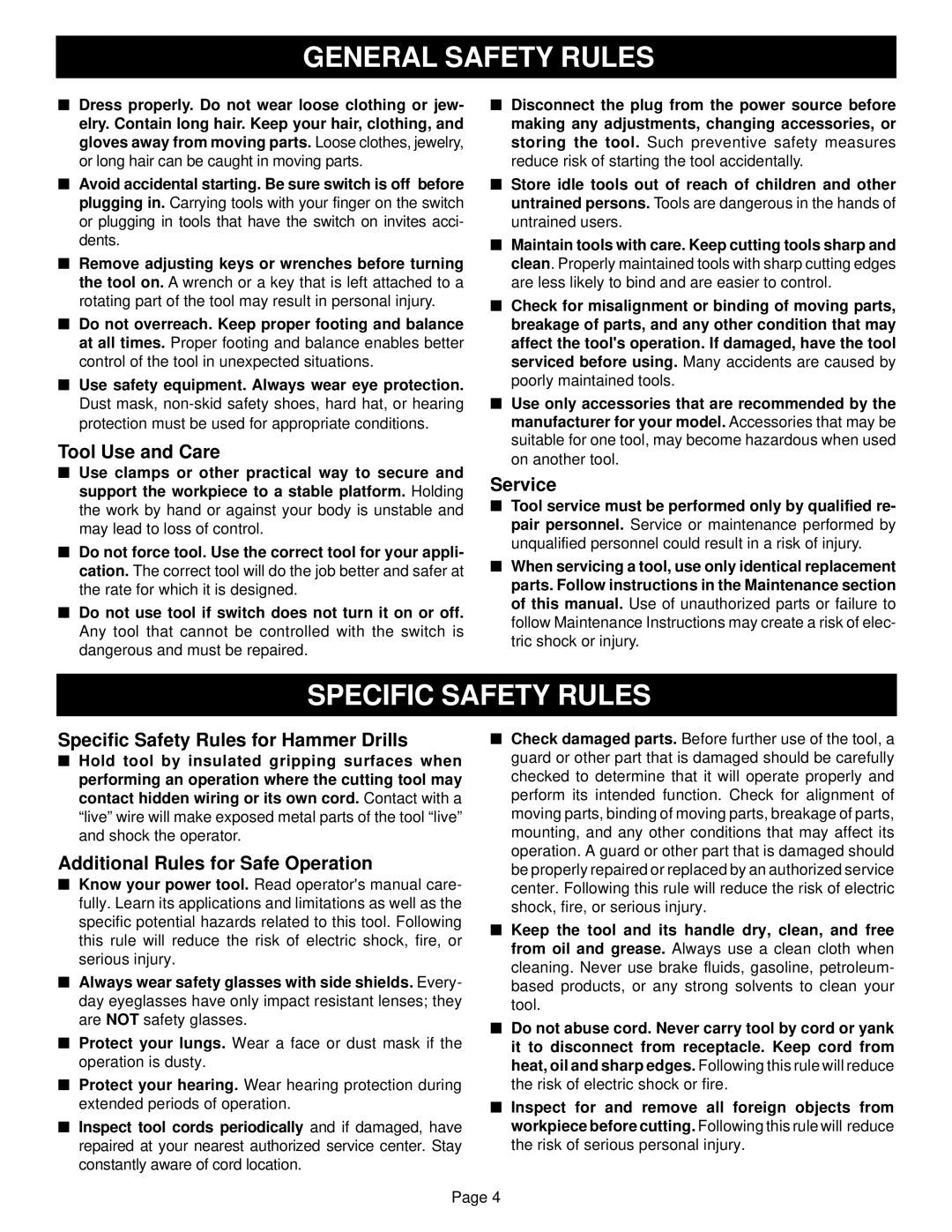
GENERAL SAFETY RULES
■Dress properly. Do not wear loose clothing or jew- elry. Contain long hair. Keep your hair, clothing, and gloves away from moving parts. Loose clothes, jewelry, or long hair can be caught in moving parts.
■Avoid accidental starting. Be sure switch is off before plugging in. Carrying tools with your finger on the switch or plugging in tools that have the switch on invites acci- dents.
■Remove adjusting keys or wrenches before turning the tool on. A wrench or a key that is left attached to a rotating part of the tool may result in personal injury.
■Do not overreach. Keep proper footing and balance at all times. Proper footing and balance enables better control of the tool in unexpected situations.
■Use safety equipment. Always wear eye protection. Dust mask,
Tool Use and Care
■Use clamps or other practical way to secure and support the workpiece to a stable platform. Holding the work by hand or against your body is unstable and may lead to loss of control.
■Do not force tool. Use the correct tool for your appli- cation. The correct tool will do the job better and safer at the rate for which it is designed.
■Do not use tool if switch does not turn it on or off. Any tool that cannot be controlled with the switch is dangerous and must be repaired.
■Disconnect the plug from the power source before making any adjustments, changing accessories, or storing the tool. Such preventive safety measures reduce risk of starting the tool accidentally.
■Store idle tools out of reach of children and other untrained persons. Tools are dangerous in the hands of untrained users.
■Maintain tools with care. Keep cutting tools sharp and clean. Properly maintained tools with sharp cutting edges are less likely to bind and are easier to control.
■Check for misalignment or binding of moving parts, breakage of parts, and any other condition that may affect the tool's operation. If damaged, have the tool serviced before using. Many accidents are caused by poorly maintained tools.
■Use only accessories that are recommended by the manufacturer for your model. Accessories that may be suitable for one tool, may become hazardous when used on another tool.
Service
■Tool service must be performed only by qualified re- pair personnel. Service or maintenance performed by unqualified personnel could result in a risk of injury.
■When servicing a tool, use only identical replacement parts. Follow instructions in the Maintenance section of this manual. Use of unauthorized parts or failure to follow Maintenance Instructions may create a risk of elec- tric shock or injury.
SPECIFIC SAFETY RULES
Specific Safety Rules for Hammer Drills
■Hold tool by insulated gripping surfaces when performing an operation where the cutting tool may contact hidden wiring or its own cord. Contact with a “live” wire will make exposed metal parts of the tool “live” and shock the operator.
Additional Rules for Safe Operation
■Know your power tool. Read operator's manual care- fully. Learn its applications and limitations as well as the specific potential hazards related to this tool. Following this rule will reduce the risk of electric shock, fire, or serious injury.
■Always wear safety glasses with side shields. Every- day eyeglasses have only impact resistant lenses; they are NOT safety glasses.
■Protect your lungs. Wear a face or dust mask if the operation is dusty.
■Protect your hearing. Wear hearing protection during extended periods of operation.
■Inspect tool cords periodically and if damaged, have repaired at your nearest authorized service center. Stay constantly aware of cord location.
■Check damaged parts. Before further use of the tool, a guard or other part that is damaged should be carefully checked to determine that it will operate properly and perform its intended function. Check for alignment of moving parts, binding of moving parts, breakage of parts, mounting, and any other conditions that may affect its operation. A guard or other part that is damaged should be properly repaired or replaced by an authorized service center. Following this rule will reduce the risk of electric shock, fire, or serious injury.
■Keep the tool and its handle dry, clean, and free from oil and grease. Always use a clean cloth when cleaning. Never use brake fluids, gasoline, petroleum- based products, or any strong solvents to clean your tool.
■Do not abuse cord. Never carry tool by cord or yank it to disconnect from receptacle. Keep cord from heat, oil and sharp edges. Following this rule will reduce the risk of electric shock or fire.
■Inspect for and remove all foreign objects from workpiece before cutting. Following this rule will reduce the risk of serious personal injury.
Page 4
